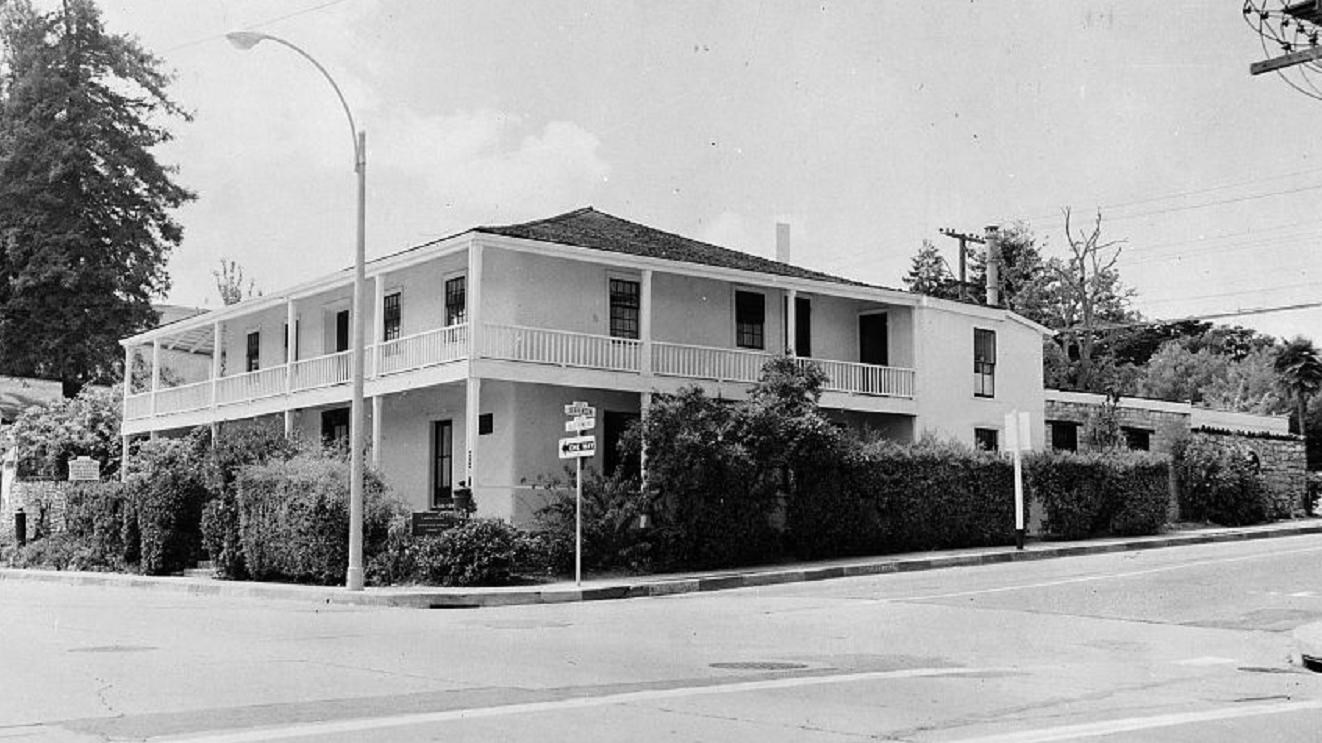Last updated: January 24, 2023
Place
Larkin House, CA

Historic American Buildings Survey; Retrieved from the Library of Congress
The Larkin House, a National Historic Landmark, is a two-story mud adobe brick home built during Monterey’s Mexican period by Thomas O. Larkin, a New England Yankee merchant who was highly successful and influential in early California politics. Thomas O. Larkin (1802-1858) was a, financier, confidant of California officials, and United States Consul to Mexican California. He not only exerted great influence on the political history of California, but also influenced the development of Californian adobe buildings. In the 1830s, the Larkin House became the prototype of Monterey Colonial architecture. Monterey Colonial buildings mix New England and Southwestern building techniques. They are constructed with wooden frames and mud bricks to make a leaner, sturdier adobe buildings than ones made primarily from mud and straw. The greater stability of Monterey buildings--compared to single-story adobes--allows for a large second-story and long covered porch. The covered second story porch also protected the adobe façade and walls of the house from water damage. By adapting an east coast building form to available California materials, adobe and redwood, and to California architectural preferences, Larkin created a style that synthesized elements of two very different cultures, that of the Spanish and Mexican colonists and of the Americans moving into California.
Born in Massachusetts in 1802, Larkin spent the first decades of his life pursuing various business ventures along the east coast of the United States. After attempting several businesses and having little success, Larkin decided to join his half-brother, John B.R. Cooper, in Yerba Buena (original name of San Francisco), California. Larkin sailed from Boston to Monterey in 1831 aboard the ship Newcastle. On board, he met Rachel Hobson Holmes, also from Massachusetts, who became his wife in 1833. Once in California, Larkin worked as a clerk in his half-brother’s business for about a year until he had enough money to go into business for himself.
Larkin quickly became a leading and affluent citizen in Monterey, developing an important commercial and trading business along the coast. As the most successful merchant in Mexican California, Larkin exported and imported a variety of goods selling items such as cloth, clothing, furniture, china goods, crockery, farming implements, sugar, and rice. He opened his first store in Monterey in 1834, and in the same year began construction on his first house.
The building was to serve as both a home and a store. Larkin followed a traditional Massachusetts model as the basis for the design but had to adapt this model to construction materials that were available. When he could not obtain enough redwood locally to construct a building entirely of wood, Larkin incorporated local adobe building techniques into his design. By blending the architectural styles, Larkin was able to create a building with a lighter shell of adobe bricks. This lighter shell made it easier to construct structural openings (windows, doors, etc.) than had previously been possible in traditional Spanish and Mexican adobe buildings where the adobe material predominated.
As one of the first two-story houses in Monterey and likely the first home in California to have an interior chimney/fireplace, the Larkin House marks a turning point in the development of California adobe buildings. The distinctive broad roof that overhangs the second floor windows and the second story balcony are stylish as well as practical and became the standard for adobe buildings of the period. Also, Larkin made the first floor rooms in the house interconnecting, which was different from the Spanish-Mexican adobes where rooms generally opened only out onto a patio. On the second floor, Larkin followed the traditional adobe floor plan of providing access to the rooms only from the outside. Widely imitated throughout Monterey and California, the Larkin House represented a cultural middle ground where the blending and adaptation of cultural norms created something entirely new.
Larkin not only influenced the development of early California adobe buildings, he was also a key figure in the early political history of California. Because of his knowledge and prominent position in the Californian community, Larkin in 1844 received an appointment as the first (and what turned out to be the last) U.S. Consul to Alta California under Mexican rule. His house became a gathering place for Americans, as well as the governmental headquarters and the center of the social life of Monterey. Monterey was the Mexican capital of California from 1826 until the American occupation in 1847.
Larkin liked California so much he wanted it to become part of the United States, fearing that if it did not it would fall under the control of France or Great Britain. In 1845, Larkin received discreet orders from Secretary of State James Buchanan to serve as a confidential agent of the U.S. government and to assist any attempt at secession from Mexico. In the years that followed, Larkin was a key figure in the events leading to the annexation of California. Larkin’s historic decisions regarding California’s future were often made right from his influential adobe home.
In 1850, after the Mexican War, Larkin sold his Monterey house and moved to San Francisco where he built the first brick building in the city at 1116 Stockton Street. The Larkin House in Monterey that he left behind passed through many owners until 1922 when Larkin’s granddaughter, Alice Larkin Toulmin, purchased the home as a private residence. In 1957, she donated the historic house to the State of California. Today, the house is filled with early 19th century antiques from all over the world. Visitors can tour both floors and learn about Thomas O. Larkin and his role in the history of California that so intertwines Latino and Anglo cultures. The house is included in the Monterey Old Town Historic District, which is a part of Monterey State Historical Park. There are free guided tours available at the park.
